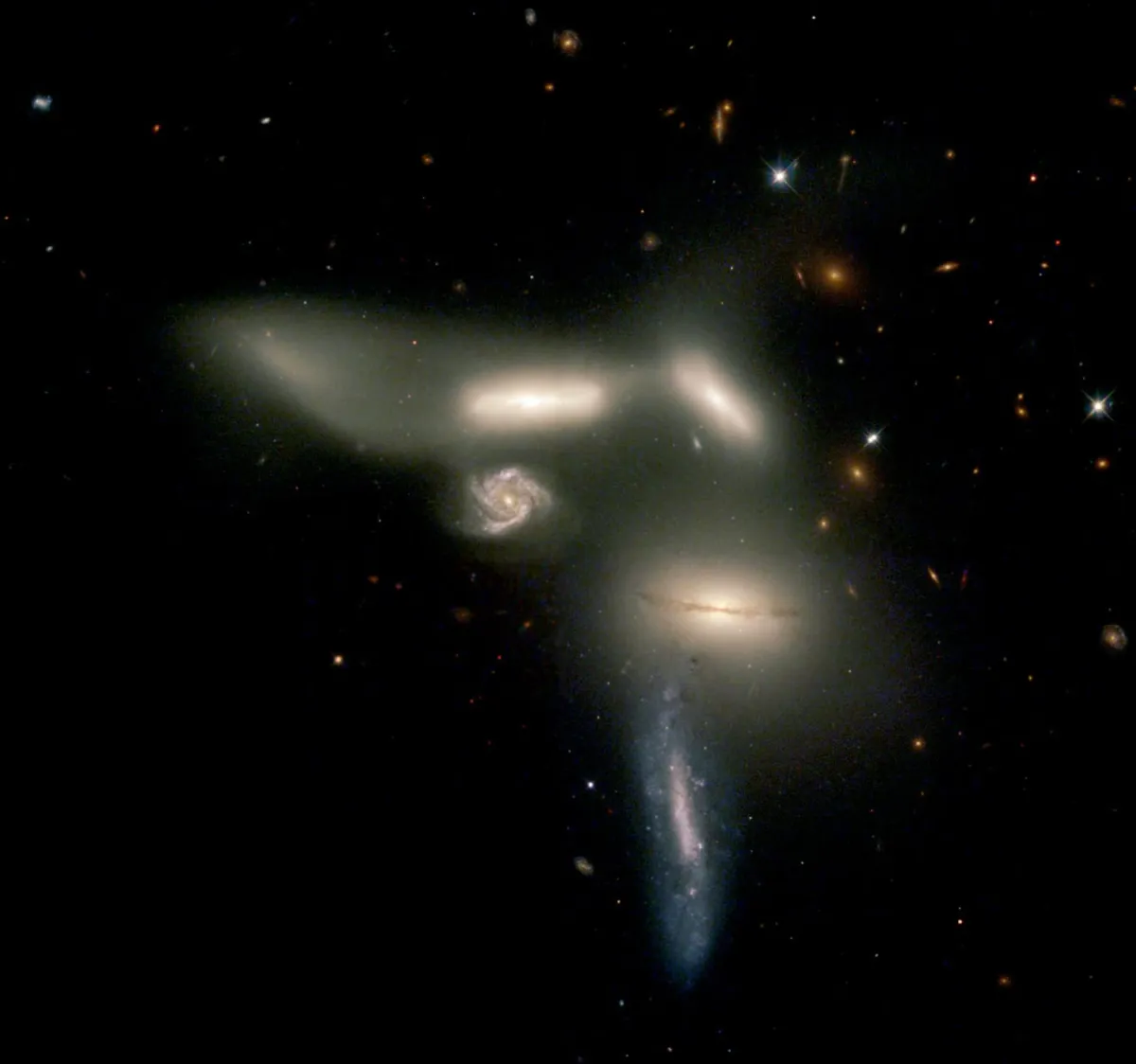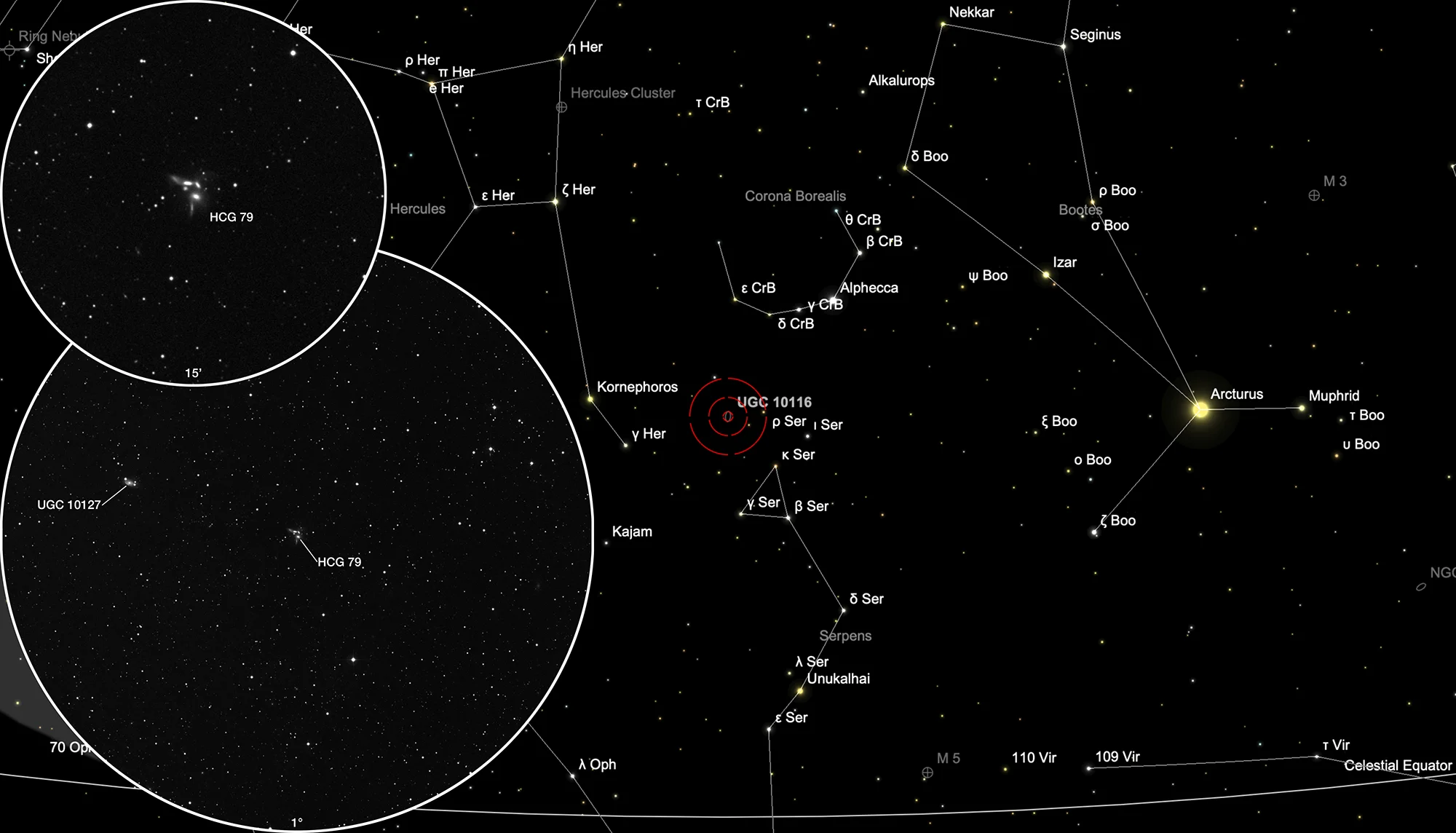Seyfert's Sextet (Hickson 79)

History
This group of galaxies was discovered on 17 June 1876 by the French astronomer Jean Marie Édouard Stephan. From 1866 to 1907 he was director of the observatory in Marseille and used the 31 inch Foucault reflector. He noted: «Excessively excessively faint; surrounds a very small star; appears to reach 2 other fainter ones.» John L. E. Dreyer added it in 1888 as NGC 6027 to his «New General Catalogue». [277, 313, 568]
In the late 1940s during an investication of faint galaxies made at the Barnard Observatory of Vanderbilt University the astronomer Carl Seyfert discovered that it was not a single galaxy, but an exceedingly compact group of six galaxies. Walter Baade suspected on the photographs with the 100 and 200 inch telescopes that one apparent member of the sextet was not a galaxy but simply a tidal tail stripped off of one of the other members and that the small spiral due to its abnormal size might not be a true member of the group. [569]
In 1959 the Russian astronomer Boris Vorontsov-Velyaminov published his «Atlas and Catalogue of Interacting Galaxies». This group of galaxies is referred as VV 115. [432]
The British-Canadian astronomer Paul Hickson presented in 1982 his systematic search for groups of galaxies on the photo plates of the Palomar Observatory Sky Survey (POSS) to the public. He counted five members in this group.
Physical Properties
This is a grouping of galaxies entangled in gravity that could bring them together to form one large elliptical galaxy. They are so tightly packed together that gravitational forces are ripping stars from them and distort their shapes. Unlike other interacting galaxies this group shows no evidence of characteristic blue regions of young star clusters. It may be that it is at the beginning of interaction, before much has happened.
The group resides 190 million light-years away and spans just 100'000 light-years, occupying less volume than our Milky Way galaxy. Each galaxy is about 35'000 light-years in diameter. The nearly edge-on spiral galaxy remains relatively undisturbed, except for the slight warp in its disk. The small face-on spiral with the prominent arms of gas and stars is a background galaxy almost five times farther away than the other four. [567]
| PGC | RA | Dec | Type | Dim | Btot | HRV | PA | Names |
|---|---|---|---|---|---|---|---|---|
| PGC 56575 | 15 59 10.4 | +20 45 38 | C M | .4 x .2 | 15.1 | 4413 | NGC 6027, (UGC 10116), MCG 4-38-8, (CGCG 137-10), (7ZW 631), (VV 115), IRAS 15570+2053, HICK 79C | |
| PGC 56576 | 15 59 11.4 | +20 45 15 | C M | .7 x .5 | 14.7 | 4197 | NGC 6027A, (UGC 10116), MCG 4-38-6, (CGCG 137-10), (7ZW 631), (VV 115), HICK 79A | |
| PGC 56578 | 15 59 12.0 | +20 44 47 | C M | .9 x .2 | 16.5 | 4482 | NGC 6027C, (UGC 10116), MCG 4-38-7, (CGCG 137-10), (7ZW 631), (VV 115), HICK 79D | |
| PGC 56579 | 15 59 12.7 | +20 45 47 | C M | .8 x .4 | 14.2 | 4095 | NGC 6027E, (UGC 10116), MCG 4-38-10, (CGCG 137-10), (7ZW 631), (VV 115), HICK 79B | |
| PGC 56580 | 15 59 13.1 | +20 45 33 | C M | .2 x .2 | 16.3 | 19813 | NGC 6027D, (UGC 10116), MCG 4-38-9, (CGCG 137-10), (7ZW 631), (VV 115), HICK 79E |
Finder Chart
Seyfert' Sextet can be found in the head of the constellation Serpens. On 23 May it is in opposition to the Sun and crosses the meridian at local midnight. The best time for observation is in the months from January to October.
